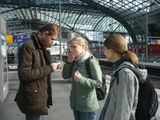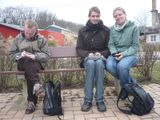2009-03-01 52 12
| Sun 1 Mar 2009 in 52,12: 52.3552815, 12.9206630 geohashing.info google osm bing/os kml crox |
Participants
Plans
Looking for a nice weekend hash, we discovered this place in our neighbor graticule, which caught our eyes mostly because it was on an intersection in a village, and there seemed to be some nice lakes close by. When we checked the maps (we have actual paper maps of this area) this morning, we discovered a Brickworks Museum close by and the decision was set. lyx phoned up two of our friends and neighbors who enthusiastically accompanied us on the expedition.
Expedition
It was one of the first warm and sunny days, witnessing of the spring time that is about to come. We met with Antje and Andreas at the bus station and headed off to main station. From there, a regional train would take us to Werder, from whence it is a mere 6km walk to todays hash point. We kept Andreas in the dark about that last little point. With the sun blazing from the sky, they even put on some sunscreen.
After a short and undescript train passage, we reached the little town of Werder upon Havel, which is best known for its fruit production, mostly of apples and cherries, and an annual binge drinking party disguised as cherry blossom time festival.
We set out happily chatting and saw a bakery selling yesterday's produce, a nice old gate of an engineering company (nice as in having that Eastern Bloc charme), and generally had a jolly good time. There were knotty old trees in the towns forest, which had a not entirely spectacular sight on the lakes. We learned later that the hill on which the forest grows, just as many other in the area, are overburden residues from the industrial extraction of clay. Down the stairs again, we passed some of the cherry trees(?) the town is famous for (while the rest of the roads looked more like this).
But soon enough, there were signs pointing out the brickworks museum, and eventually we reached the crossing next to the hash itself. Oh joy, we did not even need to resort to a GPS device as the satellite and cartographic survey was unambiguous. The hash lies in the middle of a single lane road. The area is called the Glindower Alps, again due to the heaping of residue earth from the clay extraction.
Right next, I would like to add, to the Glindow Brickworks Museum, along with a historic brickworks, which is still active producing bricks and decorative elements out of clay for the reconstruction and maintenance of historic buildings (or sometimes less historic ones). The museum itself is just that tower, though. There was a sign indicating the opening hours (12am-4pm) and times (beginning on March 1. Yay for pure chance!). The front door was locked, though. So we circled the tower once, peering through the windows and sat down on a nearby bench for a picnic.
That's when a man, who had been chatting with two other people at a nearby van, yelled at us whether we were here for the museum. relet approached him and explained that - well yes, we would have come to see what there is to see. A few minutes later, he opened the door for us and gave us a highly interesting and very friendly private tour. Apparently a third of the town of Berlin had been dug out in the area when it comes to clay bricks, totalling some 28 trillion bricks. They were produced in manual labor, with the children and women helping in the drying and turning of the bricks. The bricks would then be sent by boat into the capital. A typical salary for a worker would be few more than one Mark for every thousand bricks - with the company earning 25 Mark per thousand. The bricks could be easily distinguished from the other provenances by their yellowish to green colour.. many other red clay brick buildings would come from the area of Rathenow. Today, the furnace still produces clay parts for historic buildings, all by hand. They are able to reproduce most colors from white to black, into red and green, to match the aged look required to fit with the rest of the building. This is done by mixing clay from various sources.
It is possible to observe the actual works in the furnace (schematics, side view), but only on Wednesdays and when there are open orders.
After the museum, we took a few more steps to the shore of the lake where we sat down again to eat a few more chips and cookies. We also performed some mysterious activity greatly helped by the presence of the museum. Oh look! Penguins! A few suspicious moments later, we snuck back for the return trip. We actually don't know why exactly we snuck, and when we realized this, were unable to hold our laughter.
We would have taken the bus back, if there had been any, but there was not. This left us with the opportunities to act even more suspicious, walk a little more, and eventually reach a better frequented bus stop. Andreas then confessed that he would not have walked something like 10km in the whole year, and wouldn't have considered to do that in a day. Oy. But he survived and did not seem too unhappy about it in the end.
Tracklog
None. It was no batteries this time.
Photos
inline.
Hashcards
Card sent to ilpadre
"Thank you for your recent hashcard! Today, we went to the Glindow Brickworks Museum, where we received a private tour on the first day of opening. The hash is behind the viewer. Gut Brandt! (That's what they say here)"
Card sent to Ekorren
Card sent to dawidi (other side is the same as ekorren's)
Card sent to Arvid
Back of card sent to Arvid








































